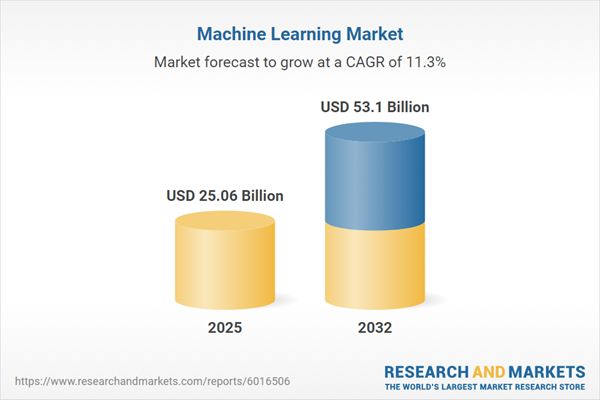Speak directly to the analyst to clarify any post sales queries you may have.
The machine learning market is undergoing accelerated transformation as organizations prioritize strategic adoption to drive operational resilience, efficiency, and innovation. Senior decision-makers now view machine learning not merely as a technological upgrade, but as a critical lever for competitive differentiation and sustainable growth across sectors.
Market Snapshot: Machine Learning Market Growth Outlook
The global machine learning market is on a steady growth trajectory, expanding from USD 22.56 billion in 2024 to USD 25.06 billion in 2025. With a projected CAGR of 11.29%, it is poised to reach USD 53.10 billion by 2032. This surge is powered by technological advancements, an increased focus on automation, and rising demand for data-driven decision-making in both established and emerging industries.
Scope & Segmentation: Comprehensive Market Coverage
- Hardware Solutions: ASIC solutions (FPGAs, TPUs), CPU architectures (ARM CPUs, x86 CPUs), edge devices (AI accelerators, gateways), GPU platforms (AMD GPUs, NVIDIA GPUs).
- Services: Consulting (strategy, implementation, integration), managed services (infrastructure, ML model management), professional (custom development, deployment, integration, training and support).
- Software Tools: AI development tools, deep learning frameworks (MXNet, PyTorch, TensorFlow), machine learning platforms (automated ML, MLOps, model monitoring), predictive analytics software (anomaly detection, forecasting, prescriptive analytics).
- Deployment Modes: Cloud services (IaaS, PaaS, SaaS), hybrid deployments, on-premise solutions.
- Applications: Computer vision (facial, image, video analysis), fraud detection (identity, insurance, transaction), natural language processing (chatbots, sentiment analysis, text mining), predictive analytics (anomaly detection, forecasting, prescriptive), recommendation systems (collaborative filtering, content-based, hybrid), speech recognition (speech-to-text, voice biometrics).
- End User Industries: BFSI (banking, capital markets, insurance), energy & utilities (oil and gas, power generation, renewables), government & public sector (defense, education, public administration), healthcare, IT & telecom, manufacturing, retail (physical and online), transportation & logistics (air, maritime, rail, road).
- Regions: Americas, Europe, Middle East & Africa, Asia-Pacific—covering key countries such as United States, Canada, Brazil, United Kingdom, Germany, China, India, Japan, Australia, South Korea, and others.
- Leading Companies: Amazon Web Services, Microsoft, Google, IBM, Salesforce, Oracle, SAP, SAS Institute, NVIDIA.
Key Takeaways for Decision-Makers
- Organizations are embracing machine learning-powered digital transformation to innovatively reshape business models and drive new revenue streams.
- The growing accessibility of machine learning tools empowers cross-functional teams and reduces the dependency on highly specialized expertise.
- Edge computing, alongside cloud infrastructure, enables real-time analytics while minimizing latency and optimizing network efficiency.
- Automated ML platforms and robust MLOps practices are streamlining model deployment, improving governance, and supporting ongoing operational excellence.
- Ethical AI and explainability initiatives are rising in importance, with regulatory and compliance drivers shaping technology adoption and stakeholder trust.
- Industry-specific advances, particularly in healthcare, finance, and logistics, are creating targeted machine learning applications tailored to sector needs.
Tariff Impact: Navigating Supply Chain and Cost Pressures in 2025
Recent US tariffs on semiconductors, GPUs, CPUs, and ASIC accelerators are prompting organizations to realign procurement and manufacturing strategies. Firms are mitigating cost pressures by shifting toward cloud-based infrastructure, exploring alternative suppliers, and forming collaborative partnerships with hardware, cloud, and systems integration vendors. The shift to cloud also improves cost predictability and supports business continuity in response to geopolitical and trade uncertainties.
Methodology & Data Sources
This report utilizes a blend of primary interviews with industry stakeholders and comprehensive secondary research, including company filings and industry analysis. Data triangulation, scenario simulations, and peer review processes ensure the insights and segmentation are robust, actionable, and reliable.
Why This Report Matters for Machine Learning Strategy
- Supports executive decision-making by providing a structured, current assessment of market dynamics and technology shifts.
- Enables the development of practical procurement, deployment, and governance strategies that reflect complex regulatory and regional factors.
- Reveals opportunities for collaboration, innovation, and risk management by highlighting industry-specific and region-specific growth pathways.
Conclusion
As machine learning moves from pilot projects to mission-critical operations, executives equipped with targeted insights and adaptable strategies will drive organizational value. This research empowers leaders to implement solutions that maximize performance and resilience in a rapidly evolving landscape.
Additional Product Information:
- Purchase of this report includes 1 year online access with quarterly updates.
- This report can be updated on request. Please contact our Customer Experience team using the Ask a Question widget on our website.
Table of Contents
3. Executive Summary
4. Market Overview
7. Cumulative Impact of Artificial Intelligence 2025
Companies Mentioned
The companies profiled in this Machine Learning market report include:- Amazon Web Services, Inc.
- Microsoft Corporation
- Google LLC
- International Business Machines Corporation
- Salesforce, Inc.
- Oracle Corporation
- SAP SE
- SAS Institute Inc.
- NVIDIA Corporation
Table Information
| Report Attribute | Details |
|---|---|
| No. of Pages | 183 |
| Published | November 2025 |
| Forecast Period | 2025 - 2032 |
| Estimated Market Value ( USD | $ 25.06 Billion |
| Forecasted Market Value ( USD | $ 53.1 Billion |
| Compound Annual Growth Rate | 11.2% |
| Regions Covered | Global |
| No. of Companies Mentioned | 10 |









